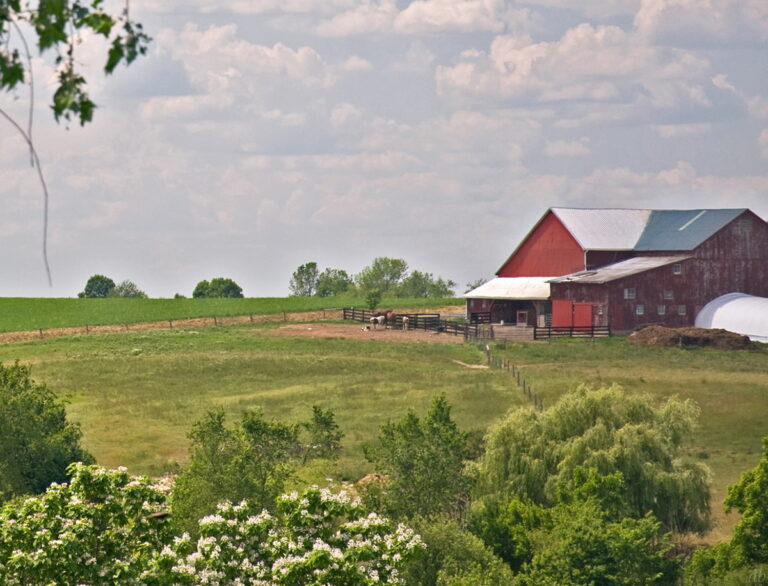Amish Donate $6,275 To Highway Department. But Are We Missing Something?
This is a neat story and a response to the idea that Amish don’t contribute to road upkeep. Amish in Monroe County, Wisconsin (Cashton settlement) recently made a donation to the local highway department. From the Monroe County Herald:
The five most northern districts of the Cashton Amish community donated $6,275 to the Monroe County Highway Department. Monroe County Highway Commissioner David Ohnstad said a group of Amish recently contacted him and said they were going to count the number of horsedrawn buggies they use and send a contribution based on that number. He said the check, which showed up at the end of November, represents 250 buggies.
And it’s not just this county:
Ohnstad’s counterpart in Vernon County told him the Amish community approached him a couple months ago about a similar donation to their highway department. Ohnstad said the donation was unsolicited but appreciated. “We do respect their gesture and take it at face value that they are interested in participating in the upkeep of the highway system,” he said.
As in other places, it appears there is a history of conflict over the roads in this area:
The Amish community has taken flack in the past for not contributing to the upkeep of roads despite traveling them in their wagons and buggies. While the Amish pay property taxes, most of the money to fund county roads comes from the gas tax, which is distributed by the state.
Since the Amish fuel their conveyances with hay rather than gas, there isn’t much opportunity for them to support road maintenance. Licenses and registration, another form of transportation revenue, isn’t required for buggies.

Image: Mary
Amish buggies do damage the roads:
According to Ohnstad, horsedrawn buggies do have an impact on the roads. Horseshoes contribute to wear and tear on the roads in the summer as do the cleats horses wear in the winter. The steel wheels on the buggies also can damage asphalt pavement.
A few observations:
- $6,275 for 250 buggies works out to about $25/buggy
- As mentioned this is at least the second county where this has happened. Could this be a trend in Wisconsin and beyond?
- This was 5 church districts of the Cashton community. There are a total of 16 districts in that settlement. Maybe the full community is not participating. Maybe it is a “pilot program”.
- A third option, however, is that the Vernon County contribution also refers to this same community – the Cashton Amish settlement covers both counties. That’s probably what I would guess happened here. However, there are 4 other settlements in Vernon County, so not necessarily.
And some quibbles (this is the “are we missing something” in the blog title):
- Are the Amish really not contributing because they don’t own cars and purchase fuel for them? Or is that a bad assumption? Amish do purchase gasoline to power their equipment, such as generators, lawn mowers, tillers, chainsaws, etc. This can be significant. One Amishman estimated his family buys 8-10 gallons/week in winter, and double that in summer. When you look at maintaining a large yard, garden(s), pasture, wooded area, etc., that can take some gasoline…
- Many Amish – at least outside the plainer communities – hire Amish taxis for transport and thus are indirectly purchasing gas.
- Over the course of a year, does the average buggy damage the road as much as, less than, or more than the average car?
In some communities, Amish provide funds through more formal means – such as buggy license fees in Indiana, or a “road tax” and per-buggy fee in Ohio.
Interesting to see this story, and hopefully the contribution goes not only towards road upkeep, but also the upkeep of good relationships in this community.







Buggy Lanes
Perhaps the Amish that have donated are hoping for buggy lanes.
Is there something I missed that suggested that? Everything seems to suggest it is meant for road upkeep. I wasn’t able to access the entire article (was behind a $49 paywall) so perhaps there was some additional detail.
You didn't miss anything that I'm aware of.
Erik, you didn’t miss anything that I’m aware of. I stated “perhaps” and “hoping” as I thought that may be a possibility. Most Amish in our area (central, IL) are very appreciative of the few buggy lanes that there are. However, I’m not aware of any that specifically requested them. Technically buggy lanes do assist with road upkeep.
Donations to highway dept.
It would be good to have the money donated to be used to help install buggy lanes for the buggys. It is also well known that alot of cars still use studded tires in the months. Work together in the road consideration
carbon footprint
I’m not sure why anyone would worry too terribly much about the Amish buggies wearing the roads. Perhaps jealousy? Sure, I get upset when I had to pay $126.50 excluding sales tax or registration, each, for Wisconsin titles for a few car projects that likely won’t hit the road for a few years, seems like it was only 40 something dollars prior to our current governor. I remember when it was only $25 not too long before that. But then again, I remember when registration for a car was only $25 in the 80’s but still only about $70, much better than many other states and in line with inflation, but the title fees have for sure gone up more than my wages. Thankful for collector plates…point being I pay more than most in my state, being an automobile enthusiast, for the lifestyle I choose. If anyone is bothered that those with a buggy aren’t paying what they are, they can sell their car and buy a buggy…no emissions test either, LOL! In these days where everyone says, “go green”, it would seem silly to tax bicycles or buggies. I did discover thet there is a surcharge to register an electric car in WI, yet they are planning to phase out gasoline cars in the future in favor of electric…